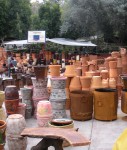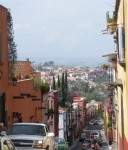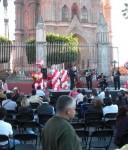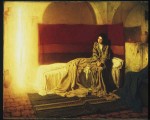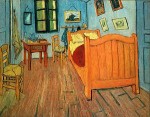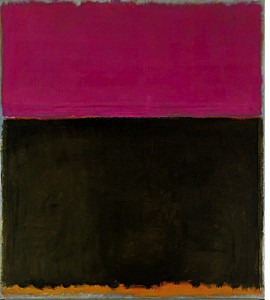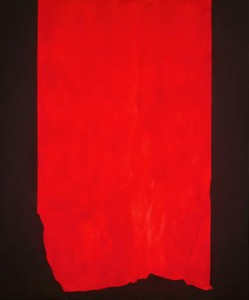Posts tagged ‘painting’
3 Days in San Miguel, part 2
-
Flower pots at the flower mart.
-
San Miguel, now a sprawling community.
-
Sunday afternoon in front of el Parroquia.
- Flower pots at the flower mart.
- San Miguel, now a sprawling community.
- Sunday afternoon in front of el Parroquia.
Accessing deeply-embedded memories is like opening doors to rooms that have long been shut.
I had the opportunity to return to San Miguel de Allende 35 years after I had spent a semester there in college. I wasn’t sure what to expect but I was both excited for the chance to see things long forgotten and apprehensive at what the experience might produce.
My journey took me from Dallas to Leon, a regional airport near Guanajuato City and the closest airport to San Miguel. It was clean, contemporary and efficient. I passed through customs with little trouble and my driver was waiting for me as I departed.
I had researched ground transportation services on the web and there were a few that offered acceptable rates, but I chose the one suggested by my hotel. It was by far the most expensive, but as I didn’t want to take any chances with getting into the wrong car with the wrong person in a foreign country, I figured the $300 round-trip car fare was worth the price.
My driver was personable and talkative. We spoke at length about my previous visit; in fact, I had lived in San Miguel before he had ever been born. He also gave me a few impromptu Spanish lessons in the car as we drove the 110 miles to San Miguel.
The mountainous terrain en route was desolate and beautiful, with long stretches of brush, cactus and tumbleweed. It reminded me of the hills outside of Taos, if you take the roundabout way to Sante Fe. In my mind, I heard the echoes of a lonesome Marty Robbins’ song as we drove through a series of one-horse towns, each with a few shacks and a cantina.
Day 1
We entered San Miguel from a direction I had not previously remembered, so as we pulled up to the outskirts of town, I got a brief sinking feeling when I saw nothing reflective of the memories I had stored for 35 years. But that passed quickly as my driver made some turns and wended his way through narrow streets and back alleys. Soon, we were in front of the Parroquia at the Jardin and it was as if I had never left.
I arrived on a Sunday afternoon and townspeople were sitting on chairs and benches, a small band played mariachi music, and young men and women were starting to congregate for ‘the walk.’ My hotel, the Casa de Sierra Nevada, was only a block away. I quickly checked in and got settled in my room, then headed back out the door.
I passed by my former apartment house, now a small hotel, and the building where we held our classes, now a furniture store. The restaurants I remembered were either gone or under new names. I also found places whose names I recognized but where I hadn’t spent any time at all. The Escuella de Bellas Artes was one such place — an architecturally rich building with lush verdant grounds that was once a convent but now an art school. Small retail stores, many selling jewelry and high-end consumer goods, had opened. Female shopkeepers were fashionably dressed. It became apparent that San Miguel had prospered in the last few decades. The town had grown into a small city of 60,000, many of them Americans, and had developed sprawl. While the historic central core of San Miguel retained its original charm, new homes and shanty towns had grown up on its outskirts.
I finished my day by dining at Tio Lucas near the Bellas Artes. The food was simple but good and I’d sampled a few of the local cervezas. By the end of dinner, it was 9pm and I headed out into the open air. San Miguel is dark and poorly lit; what little light there is at night casts deep shadows on people, cars and alleys. It’s easy for a person to recede back into a doorway at night and be completely hidden from view. The streets are long and hilly, it’s difficult to see around corners, and the sidewalks are narrow, allowing only one person to walk in one direction without stepping into the gutter. Mindful of a news story I had just read about kidnappings and murders in Mexico, I was nervous that first night walking the 5 or 6 blocks back to the hotel, but I got there without incident.
Day 2
After I had locked myself in for the evening, I realized the bells at the Parroquia, the parish church one block away, chimed every 15 minutes of every hour all through the night. Those crazy Mexicans! It was impossible to get a good night’s rest. So after a fitful sleep, I showered, dressed and headed out the door at 8am, still a bit groggy but excited to see other parts of San Miguel.
The day was cloudy and cool with a mist of rain. I had breakfast at a quaint little restaurant three blocks from the hotel. Hundreds of baskets hung from the ceiling and posters of the owner, a film actress and cabaret singer from Mexico City, adorned the walls. The posters showed her in several poses from her movie roles. She was clearly proud of her good looks and celebrity.
After breakfast I headed east to a part of town I had never really visited before. I stumbled upon a flower market with hundreds of plants in full bloom. The smell was like an aphrodesiac — fragrant, perfumy and arousing. Nearby, a basketball court was stacked high with flower pots of all shapes, sizes and colors.
For the next few hours, I wandered the streets, stopping occasionally to look into a few shops and hotels. Many of the homes are built in the Baroque colonial style, with high walls and large doors facing the street that open to spacious and colorful courtyards. There was a brass plaque on one such door, listing the word, Sculptor, next to the owner’s name. As I was peeking in a window to see if there was any activity inside, a voice from behind me asked, in English, if I had wanted to go in. Andrew was Canadian, a snow bird who spent six months every year in San Miguel. He showed me his studio, which he rents with 3 Americans — James from Detroit, June from Omaha and Mike from Cleveland. We chatted about life and art in San Miguel. I asked about home prices and was surprised to learn that the going rate for an updated home in the historic central core would run from $600,000 to $1 million US. So much for having a pied à terre in San Miguel.
By this time it was 2pm. The clouds had lifted, the sun was shining and I found a little restaurant with outdoor seating in a courtyard of shops and offices. It was shady, colorful, warm and inviting. I placed an order and was full in the moment of enjoying the day when I casually glanced over my shoulder. A local police officer, wide and powerfully built, was standing at the entrance and staring intently at me. His expression was provocative; I took it as a warning — one I inferred to mean, ‘Watch your step.’ I held his gaze for a moment, perplexed as I didn’t understand what was happening and why he might be interested in me, but then looked away. ‘Why ask for trouble?,’ I thought to myself. Two other diners at a nearby table noticed and looked in my direction. The officer left a few moments later but that brief exchange unnerved me and foreshadowed a disquieting spectacle that was to occur the following day — one which colored the remainder of my trip and which I still think about today.
For the conclusion of this story, read 3 Days in San Miguel, part 3
Leave a comment
30 Jan 2012
Sliding Doors
- “The Annunciation” by Henry Osawa Tanner
- Bedroom in Arles, by Vincent Van Gogh
I subscribe to Joseph Campbell’s belief that religious institutions often stand in the way of religious experience. I no longer belong to an organized religion but I am keenly interested in spiritual matters.
When I was about 14, I was lying in my father’s hammock in our backyard on a warm day one June, thinking intently on the origins of God. I must have fallen into a trance-like state because for a nanosecond, God became clear to me in a way He had never been before and in that spiritual epiphany, I suddenly understood how She came to be. It was a transcendent moment; it thrilled me beyond any experience I had ever had before (or have had since) but when I became conscious of what I was witnessing, the door closed, the vision disappeared as quickly as one can blink an eye, and I no longer had any recollection of what had been revealed. To this day, I can tell you nothing about that moment other than I had an ‘experience.’
There have been a few times when works of art have elicited a near-supernatural reaction in me. I remember one vividly sometime around 1971 when I was visiting Berkeley, California. I had wandered into the University art museum to see a show of paintings and drawings based on various passages in the Bible. Most of the works were traditional and predictable, until I turned a corner and saw, for the first time, the paintings of Henry Osawa Tanner and, among several works, his depiction of The Annunciation. In this small miracle of an artwork, the Angel Gabriel is represented as a shaft of brilliant light. To me, this painting is a tour de force, certainly because of Tanner’s painterly skills but, more importantly, for his unique, radical and well-ahead-of-anyone’s-time interpretation of a divine being as a beam of concentrated energy. What makes Tanner’s work all the more remarkable was his time period (1859-1937) and his race. Tanner was black and living in post-Civil War America. Perhaps he wanted to shake up the white art establishment. I like to think, however, that Tanner, himself, was divinely inspired to create this particular Gabriel. I looked at that painting for 30 minutes. When I finally walked away I thought, ‘Tanner got it perfectly right.’
I had another metaphysical moment just a few years ago, although it didn’t involve a divinity. It was more like an out-of-body-experience. I was at the Getty Center standing in front of Van Gogh’s, Bedroom in Arles, when I felt teleported inside the painting through some kind of time-shifting, altered-state experience. For a second or two, I found myself standing at the foot of that bed in that very room Van Gogh had painted. When I told a few people later about my experience, I laughed it off by blaming the funny mushrooms I must have had the night before in my Veal Piccatta, but it was a real and disorienting feeling. I can’t explain it.
I’ve had a few other metaphysical experiences and I’m sure there are many others who have had similar extra-dimensional moments. Perhaps they are attempts by the spiritual to reconnect with the physical or they’re worm holes in time and matter that allow us to peek into an alternative universe. Or perhaps they are merely delusions. I don’t pretend to know what they mean. But every chance I get, I have the Veal Piccatta and hope for another glimpse into what I don’t understand.
14 Jan 2012
My Studio
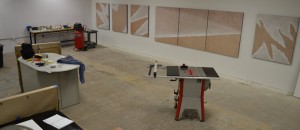 My art studio is located deep in the bowels of south St. Louis. It’s a dodgy part of town and, from the outside, the building where my studio is located looks like a place where serial killers would come to cut up their victims. But inside, the space is very nice.
My art studio is located deep in the bowels of south St. Louis. It’s a dodgy part of town and, from the outside, the building where my studio is located looks like a place where serial killers would come to cut up their victims. But inside, the space is very nice.
I have 1,500 square feet of bright white work area, 12′ high ceilings, and lots of amenities like enough power outlets for a small city, a big electrical box so we never lose juice, and a peg board that can hold all the tools in a Home Depot.
Tim is the guy who owns the building. He’s an engineer. I like having an engineer own the building rather than an artist, accountant, lawyer or insurance agent. When things go wrong in a building, you want a guy who knows how to do stuff, not a guy who makes his living running income statements. Engineers know how to do stuff and because they’re engineers, they usually over-engineer a solution so the problem is fixed for the next millenium. This is Tim’s first foray into building ownership and management. I’m his first tenant.
My former studio was located on a third-floor walkup in an old brewery. Every time I stepped into the building I’d get a flashback to when I lived in New York City in the mid-70s. My studio then was close to Bedford-Stuyvesant, which at that time was the 2nd worst neighborhood in America. You’d practically need combat pay just to get in and out of the place.
My brewery studio had wonderful light, but the windows were loose in their frames and the building was drafty. The owners seldom turned on the heat in the winter and there was no air conditioning in the summer, so for half or more of each year, I’d either be shaking or sweating. But the street had large, mature trees. There was a friendly bar just outside, a shop that sold pies a few doors down, several antique stores, and the local coffee house two blocks away was grand. They had a small reading library so, if you wanted to, you could buy a cheap lunch, find a warm spot and read Elmore Leonard all afternoon.
I stuck it out for about 15 months at the old studio, but when winter came the second time around, I just couldn’t take the cold any more. So I flew south about 8 blocks to greener pastures and central heating.
If you’re in the neighborhood, stop in and have a cool drink from the community water fountain. I’ll play some jazzy tunes from the ipod and we can snap our fingers and call each other ‘man,’ just like artists are supposed to do. And depending on how I feel that day, I may even put on a beret.
29 Dec 2011
Revisiting Rothko and Newman.
Left: Mark Rothko, ‘Untitled.’ Right: Barnett Newman, ‘Achilles.’
In my youth, I was an admirer of the painters, Mark Rothko and Barnett Newman. I studied Rothko extensively and wrote a thesis paper on Newman in graduate art school. I always thought Rothko’s work was deeper, more intense, more spiritual and primal. Yet, I admired Newman’s minimalist approach to subject matter, content and palate.
A few months ago, I saw the theatrical play, Red, the story of Rothko in late career. The actor who played the artist interpreted him as loud, bombastic, tortured and a bit of a bully. Perhaps that was Rothko’s true personality, but judging only from his art, I had always pictured him as thoughtful and contemplative, so the two sides of the man didn’t fit well for me. I didn’t think the playwright seemed comfortable in Rothko’s skin. As a result, the play was a disappointment for that and other reasons.
Around the same time, I happened upon that thesis I had written some 30 years earlier and discovered my writing was full of the pretentious, inflated, pseudo-intellectual art speak that one finds in art magazines. Like the play, my paper was a disappointing read.
I’m still of fan of Rothko’s work. Visually, his paintings have held up well over many years. Newman’s art, on the other hand, looks thin, shallow and vacant. Not sure what I thought all the excitement was about.
— Mark Travers
20 Dec 2011
